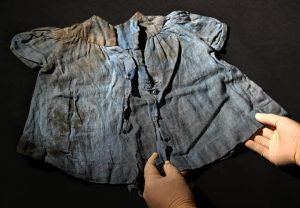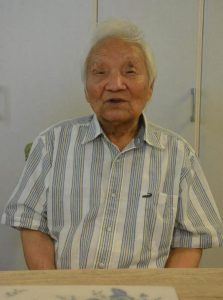Shirt worn by 3-year-old Shoji Kubo, who died year after A-bombing, donated by brother to Peace Memorial Museum as evidence of Shoji’s life
Aug. 6, 2023
Shirt discolored by A-bombing’s thermal rays
by Kyosuke Mizukawa, Senior Staff Writer
The shirt worn by a three-year-old boy at the time of the atomic bombing is badly discolored, especially around the right side, the area hit by the A-bombing’s thermal rays. The shirt belonged to Shoji Kubo, younger brother of Tomoyuki Kubo, 89, an A-bomb survivor who now lives in Osaka City’s Minato Ward. Shoji suffered severe burns to his head and died the year after the bombing. No photographs of him remain. Tomoyuki donated the shirt, which had been kept by his family, to the Hiroshima Peace Memorial Museum, located in Hiroshima’s Naka Ward, as evidence of Shoji’s existence.
Before the atomic bombing, the Kubo family operated a bathhouse in the area of Hiratsuka-cho (in present-day Naka Ward) and lived on the second floor. In the spring of 1945, as more and more cities in Japan suffered air raids, Tomoyuki, 11 at the time, was evacuated to what is now Etajima City, where relatives lived. On August 4, he returned to his home in Hiroshima, where his family remained, to retrieve some of the family’s rice rations.
On the morning of August 6, just after Tomoyuki had left home to return to Etajima, the atomic bomb exploded over Hiroshima. That was about 1.3 kilometers from the hypocenter. Shoji, who had been looking out of a second-floor window to see off his older brother, was exposed to the thermal rays generated by the atomic bombing and suffered severe burns to the right side of his head. Buildings in the area collapsed and fires started by the bombing began to spread.
The entire Kubo family was able to escape and sought refuge with relatives on the island of Etajima. The wound on Shoji’s head from the severe burns became infected, and he had to be taken to the hospital many times. His hair stopped growing, and small red spots spread over his head. Those ailments, believed to have been effects from radiation exposure, afflicted many people who died in the period after the bombing.
Tomoyuki remembers his mother, Tsune, doing her utmost to take care of Shoji. “She said she had a responsibility to keep her child alive, and she was completely committed,” said Tomoyuki. In an attempt to help him recuperate, she even took Shoji to Beppu hot springs in Oita Prefecture.
Shoji recovered for a short time and enjoyed playing with relatives around the same age. His condition worsened, however, and he died in May 1946, just after turning four years old in March.
“Sepsis, aftereffects of atomic bombing,” reads Shoji’s death certificate, written by a physician, which remains to this day. Shoji had been in good health until the day of the bombing. There was no disputing that he had been affected not only by the thermal rays and blast from the bombing but also by the radiation, which ravaged his body.
The blue, short-sleeved shirt Shoji was wearing at the time of the bombing became a keepsake. His mother held on to it until her death in 1979, and then Mr. Kubo’s late brother kept it, before the shirt finally made its way to Tomoyuki. Nearing 90, Tomoyuki donated the shirt to the peace museum last year in November.
According to the museum, the brown discoloration is most noticeable on the part of the shirt that was closest to the right side of Shoji’s neck and shoulder, near the badly burned right side of his head. The discoloration is believed to have been caused by the intense thermal rays as well as the bodily fluids from his wounds. Few pieces of children’s clothing with telltale marks of the atomic bombing have been donated to the museum.
In recent years, Tomoyuki has been speaking about his experience in the atomic bombing at elementary schools in Osaka City. “No one in the world is unneeded,” he says, when he explains the death of his younger brother. “If atomic bombs were to be used in war again, the earth would vanish. I absolutely oppose such weapons.” On August 6 this year, he will repeat his hope for the realization of a world without nuclear weapons or war.
(Originally published on August 6, 2023)









